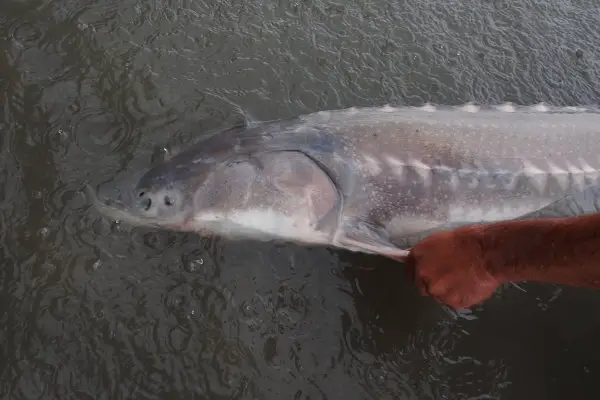I normally only write about trout, but Sturgeons fascinate me. They also happen to coexist with trout across much of their range. So how well do these two endemic species get along and what interactions occur between them?
There are eight species of Sturgeon in North America. The largest of which is the White Sturgeons whose natural habitat greatly overlaps with Rainbow trout and Steelheads.
I am going to answer the title question immediately. Surgeons do not predate on mature living steelheads or trout but Surgeons do readily eat dead salmonoid species, which includes steelheads. One of the best Surgeon baits just happens to be the decaying and decomposing bodies of post spawn salmon and trout.
This type of bait is quite descriptively referred to as Stink bait. I spent a couple of memorable days fishing for White Sturgeon on the Fraser River, and the bait certainly does live up to its name. The more smelly and disgusting the better. The reason why stink bait works so well is that sturgeons are bottom scavengers, and a smelly rotten bait is simply easier for them to find.
Surgeons help protect the trout by cleaning up dead fish.
Surgeons and trout coexist well, and in fact the presence of surgeons actually beneficial to the health of trout populations. The reason why? Surgeons as scavengers eat the carcasses of dead fish which prevents the decomposing corpses from polluting the waterways. The scavenging behavior will also remove a lot of diseased corpses from the water which helps slow the spread of pathogens.
Interactions between Steelheads and Surgeon?
Mature Surgeon and trout basically leave each other alone. The Sturgeons are much too big, while the trout are much too fast to become an easy meal.
But there is plenty of interaction between the two species earlier during various stages of their life cycle. Mature fish of both kinds, certainly predate on hatchlings and juveniles. During the spawn, the Sturgeons follow Steelhead and other salmon on their spawning runs. They are there to feed on fish that did not make it.
Both species also predate on each other’s eggs. Sturgeon broadcast spawners between April and July, Usually when water temperatures are between 46f and 68f. Most spawning frequently takes place in the tailwater of dams, which blocks their movement further upstream. Sturgeon spawn in deeper water than trout, they prefer water at least 3m over a gravel or bedrock bottom. Because Sturgeon are broadcast spawners, it attracts a lot of predators to feed upon the eggs, and yes that includes trout.
Trout on the other hand, usually spawn in the shallow margins of pools where they buried their eggs for some added protection. Sturgeon are opportunistic feeders, and will not think twice about sucking up any dislodged trout egg floating downstream.
I found this video showing Lake Surgeon spawning in Wisconsin. So decided to share it below.
Healthy rivers benefit both species
This should probably go without saying, but a healthy environment benefits both Sturgeon and trout. Many infrastructure projects damming and converting rivers, dumping of pollution into waterways and general overfishing threaten the survival of both trout and sturgeon across much of their previous range.
Sturgeon are incredibly slow growing, with the females not spawning until into their twenties. This slow growth rate makes them very vulnerable to overfishing and environmental degradation.

